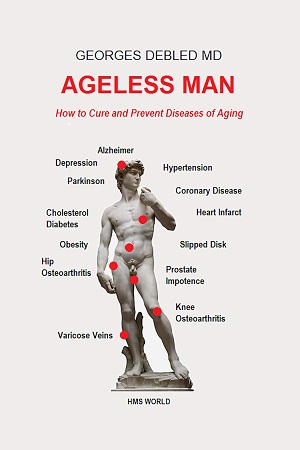How to understand
your disease of aging : ageless man
AGELESS MAN
in short
AMAZON 2017-2022 AGELESS MAN
***
Testosterone is first
a leading
hormone for
metabolism.
Curiously,
this concept is rarely considered in medical
practice while it is of the most importance.
Testosterone is
implicated in metabolism of all proteins of the
body. It regulates sugar metabolism and through
this pathway it influences the fat metabolism.
The main phenomenon
of "male climacteric"
is a lack of male hormone.
The "sexual concept" is too restrictive
because, in fact, when testosterone is missing,
all structures of the body involve
progressively through different
biochemical and pathological mechanisms.
Universality
of the androgens'
receptor
Androgen receptor
is identified in a variety of organs : seminal
vesicles, hair follicle, sebaceous glands,
foreskin glands and more generally all secondary
sexual organs, testicles and epididymis, uterus
and ovary, kidney, submaxillary glands, definite
cerebral areas as hypothalamus, pituitary gland
and the cerebral cortex, elevator ani muscle and
skeletal muscle, and bone marrow. In reality
small quantities of androgens' receptors have
been observed in numerous organs.
Protein
metabolism
The trophic action of
androgens upon the skeletal muscle is well known
for many years. It is spectacular
in
body-builders taking androgens.
According to several authors, experimental
studies have proved the effects of androgens on
the incorporation of amino acids into muscle's
proteins.
Research on rats
treated with testosterone have shown a
significant incorporation of marked leucine in
proteins and of marked uridine into
ribonucleic acid in some muscles of those
animals.
Sugar
metabolism
Already
in 1947, Giuseppe Pellegrini, director of the Institute
of Pathology from the Univerisity of Pavia in
Italy, described
the influence
of androgens on the sugar metabolism of 68
patients in an topic : " L'azione
antidiabetica degli ormonali sessuali maschili
nel quadro della fisiopathologia del diabete".
An
intramuscular
injection of 5 to 25 milligrams of testosterone
propionate provokes a significant decrease of
glycemia within the two or three hours following
the injection and its action lasts four or five
hours. The reduction of glycemia is about 1 gram
per litre with diabetics and glucosuria is
reduced. In normal man glycemia falls to
inferior plasmatic levels and not more because
hormonal balance is normal.
Regulation power
of testosterone on sugar metabolism
acts for a
long time : after an androgenic treatment glycemy of diabetics is reduced during a few
days and rises after to the initial levels.
Fat metabolism
Through the pathway
of sugar metabolism testosterone influences the
fat metabolism . When there is too much glucose
in blood, it can't be burned enough through
the Krebs' cycle (the capacity of burning is
limited) and there is an overproduction of
acetyl-coenzyme A which is the initial compound
for making cholesterol and lipids.
Because every man, some time or
other, will have a lack of testosterone
production after forty, values for triglycerides
and of cholesterol increase
in blood during aging.
Death
generally occurs after a 20 year period of deterioration
by
diseases of aging.
